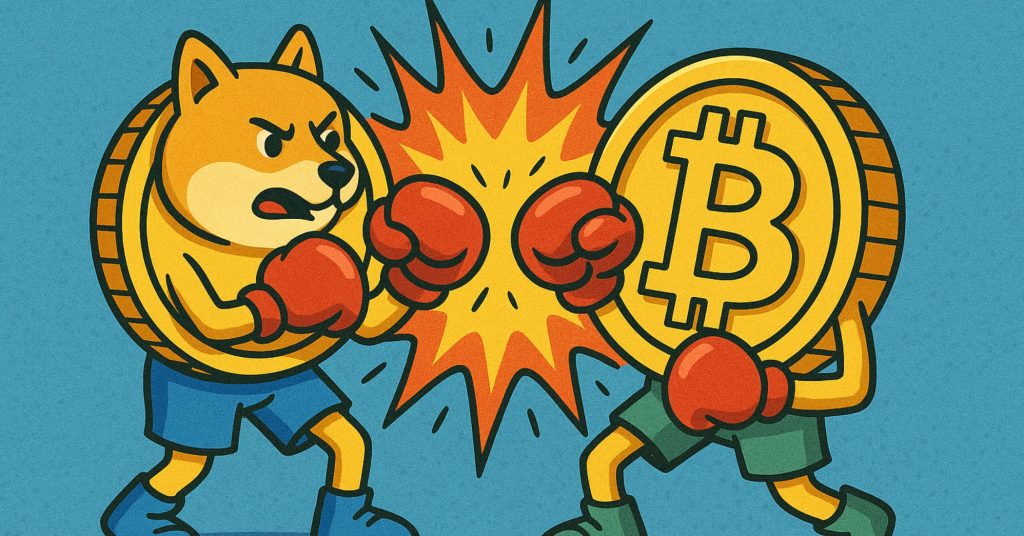On the other side, you’ve got meme coins, tokens named after dogs, frogs, or whatever’s trending online.
So, what’s the actual difference between meme coins and “normal” crypto?
In this post, we’ll break it down in the simplest way possible. You’ll learn how they work, why people buy them, and which one might fit your trading style better. Whether you’re here for the memes or the tech, this will help you tell the difference.
Already trading? Make sure you know how to check if a meme coin is legit before jumping in.
What Are Meme Coins?
Meme coins are cryptocurrencies that start as jokes, internet trends, or viral moments. They’re not built to change the financial system, they’re built to have fun, go viral, and maybe moon along the way.
Most meme coins don’t have much utility or a big tech goal behind them. They get popular because of hype, strong communities, and good timing on social media.
Some well-known meme coins include:
- Dogecoin (DOGE)
- Shiba Inu (SHIB)
- PEPE (PEPE)
- dogwifhat (WIF)
Meme coins usually cost less per token and can move fast, both up and down, which is why traders love them during hype cycles.
Curious how far they can actually go? Here’s what it would take for a meme coin to reach $1.
What Is Traditional Crypto?
Traditional crypto refers to coins and tokens that are built with a clear purpose, backed by real technology or infrastructure. These are the projects trying to solve big problems in finance, data, gaming, and more.
They’re not about memes or internet culture, they’re about tech.
Some examples:
- Bitcoin (BTC)
- Ethereum (ETH)
- Solana (SOL)
- Chainlink (LINK)
These coins tend to have strong developer teams, whitepapers, and long-term roadmaps. They’re more stable than meme coins, but still part of the fast-moving crypto space.
Want to learn more about crypto terms? Check out our crypto slang glossary so you never get lost in a conversation.
Are Meme Coins Crypto?
Yes, meme coins are crypto. They’re a type of cryptocurrency, just like Bitcoin or Ethereum. The big difference is their purpose.
While traditional crypto is usually built to solve problems or power apps, meme coins are built around fun, culture, and community vibes. They still use blockchain tech. They can still be traded. And they can still go up or down like any other coin.
So even if they started as jokes, meme coins are very much part of the crypto world. They just don’t always play by the same rules.
Key Differences at a Glance
If you’re wondering how meme coins and traditional crypto really stack up, here’s a quick side-by-side:
| Feature | Meme Coins | Traditional Crypto |
|---|---|---|
| Purpose | Built for fun and hype | Built for real-world use |
| Volatility | Super high | Still high, but more stable |
| Community | Meme-focused, viral | Tech-focused, long-term |
| Utility | Often none | Usually has clear purpose |
| Lifespan | May be short-term | Aimed at long-term growth |
| Teams | Often anonymous or casual | Structured dev teams |
Want to start with something wild? These are the best meme coins on Solana right now.
Why Do Meme Coins Get So Popular?
Meme coins spread like wildfire for a few simple reasons:
- They’re easy to understand, no complex tech, just memes
- They move fast, perfect for traders looking for quick flips
- They feel fun, great branding, silly names, and viral marketing
- They’re community-driven with Telegram and Twitter
- They’re cheap to buy in early, low entry prices pull in new traders
This makes them ideal during meme coin season when everything’s pumping off memes and momentum.
Risks of Meme Coins Compared to Traditional Crypto
Meme coins might be fun, but they come with extra risk. The hype moves fast, and so do the price swings. Some traders love the thrill, others get burned.
Here’s what to watch out for:
- Rug pulls
- No real use
- Fake copies
- Short lifespan
- Emotional trading
These scams are everywhere. Read our guide on crypto scams to avoid to stay safe.
Should You Trade Meme Coins or Stick to Crypto?
It really depends on your goals.
If you’re here to explore tech, invest long term, or understand how blockchain works, traditional crypto is probably your best bet.
If you’re just looking for fast trades, big energy, and don’t mind the risk, meme coins can be a fun ride. Just go in with your eyes open.
Many traders do both. They invest in serious crypto projects while also keeping a little SOL, ETH, or BNB ready for the next meme coin breakout.
Want a strategy that fits your style? Try one of these meme coin trading strategies that actually work.
Final Thoughts
Meme coins and traditional crypto might live in the same space, but they serve different purposes. One is built on tech and long-term goals, the other is powered by memes, speed, and community hype.
Neither is better, they’re just different tools for different types of traders. Some people love the chaos of meme season, others stick with steady plays like ETH and BTC. And plenty of traders enjoy a mix of both.
As long as you understand what you’re buying, manage your risk, and avoid falling for the hype, there’s room to have fun and stay smart in both worlds.









